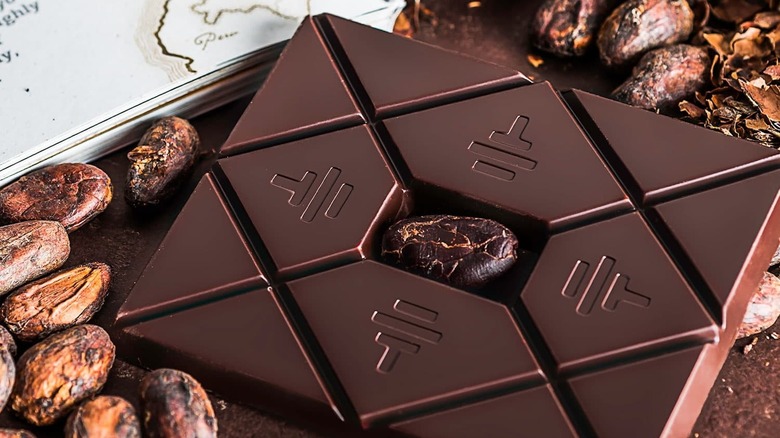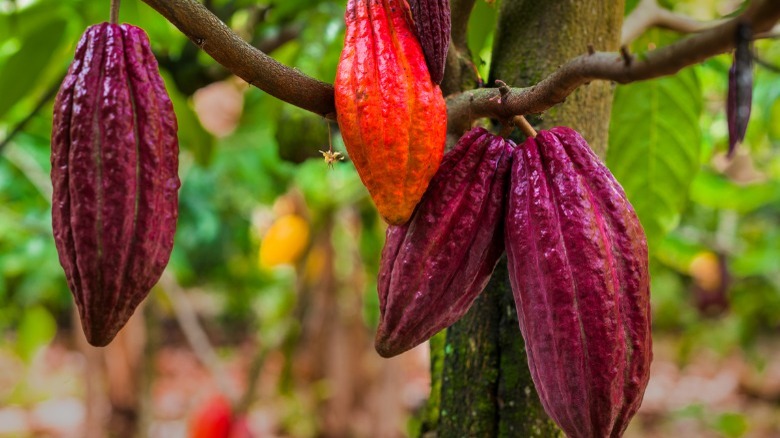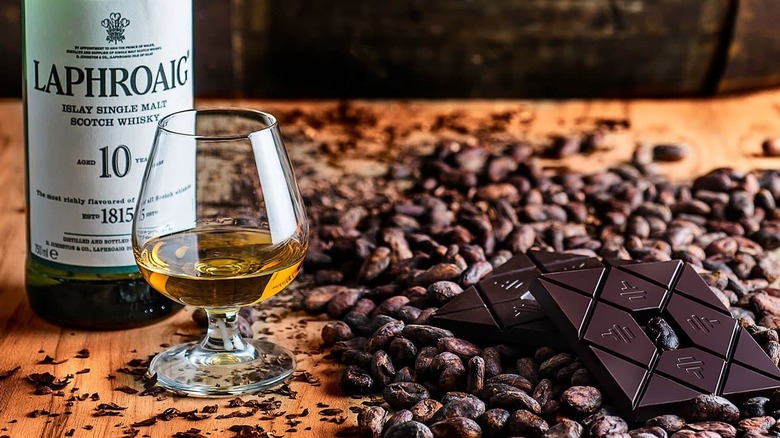The Reason To'ak Chocolate Is The Most Expensive In The World
You won't find To'ak Chocolate on the shelves of your local grocery store, and even if you could, the price tag might leave you in shock. This Ecuadorian company offers chocolate bars for hundreds of dollars — with one bar costing nearly $500 — making it the most expensive chocolate in the world. So, what's so special about To'ak, and what justifies its hefty price tag?
Just one glance at the beautiful, gilded box housing a To'ak chocolate bar reveals it as a luxury item, but the price stems from more than just the artistic packaging. To'ak chocolate is made with cane sugar and Nacional cacao, a designated heirloom cacao that is among the oldest varieties on Earth — and was thought to be extinct until 2009. The bars range in cacao percentage from about 65% to 100%.
Additionally, To'ak has been at the forefront of chocolatiers experimenting with aging chocolate to enhance its flavor, drawing on practices traditionally used for liquor. The aged editions are stored in aromatic vessels, sometimes for years, and each cacao harvest imparts different aromas and flavor profiles to the product. Ultimately, the price of To'ak chocolate reflects its unique ingredients and the significant time, effort, and care that go into making every bar.
What makes Nacional cacao unique?
Due to its rarity, Nacional cacao is one of the driving forces behind To'ak Chocolate's high price point. Nacional cacao can be traced back over 5,000 years to Ecuador, and the first cacao trees that were domesticated by humans. In 2018, archaeologists discovered pottery belonging to the indigenous Mayo-Chinchipe people, with evidence of grains and molecules that prove cacao was used for ritualistic purposes and potentially for everyday activities as well.
Although not entirely certain, researchers believe that the Nacional crop made its way north to Colombia and eventually became known as the ideal strain of cacao, specifically for European chocolatiers. Unfortunately, between 1916 and 1932, cacao production in Ecuador decreased significantly due to fungal diseases, forcing growers to introduce strains other than Nacional in an attempt to rebuild. Now, hybrid plants are common, but Nacional is rare and difficult to source.
This is where To'ak reenters the picture. Its bars are made with pure Nacional, discovered in the Piedra de Plata region of Ecuador after conducting genetic tests on the local cacao trees. Through partnerships with conservation organizations, To'ak has been able to create a reserve of pure Nacional trees, and now oversees a parcel of land where these trees grow and produce seedlings — potentially up to 5,000 every year. Its efforts to preserve the Nacional cacao population are significant, especially as global warming threatens the world's chocolate supply.
What does it mean to age chocolate?
You might never have heard of chocolate being aged before, but To'ak has been pioneering this technique since its inception in 2013. The company's approach is inspired by aging practices traditionally used for whiskey and winemaking.
Whiskey is aged in barrels, and much of the liquid's final flavor is imparted by the wood itself — it's also what gives whiskey its signature brown color. Similarly, cacao, specifically cacao butter, contains oils that are excellent at absorbing aromas. Recognizing this, To'ak stores its solid chocolate in wooden casks — some even previously used for whiskey — for up to five years. The naturally present cacao butter absorbs compounds from the wood, altering the resulting bar's flavor and color. Since chocolate pairs well with whiskey, it makes sense for To'ak to take advantage of this mingling of flavors for its aged editions.
But if it takes so many years, why even bother? Ultimately, To'ak asserts that the aging process is worth it to create a subtle flavor addition that's unique among chocolate makers. There are other brands that age chocolate, but none for the length of time that To'ak does. In the end, when you take into account the sheer amount of effort that goes into each bar's creation, the price tag starts to make a bit more sense.



